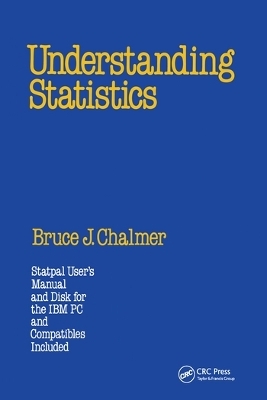
Understanding Statistics
CRC Press (Verlag)
978-0-367-58031-5 (ISBN)
Chalmer/,
Preface -- 1 Variables, Population, and Samples -- 1.1 Statistics is concerned with describing and explaining how things vary -- 1.2 Inferences about populations based on sample information are subject to error -- 1.3 Other forms of random samples include stratified and cluster sampling -- 2 Basic Ideals of Statistical Inference -- 2.1 There are two basic tasks of statistical inference -- 2.2 To evaluate degree of certainty, first consider all possible samples -- 2.3 To find degree of certainty, find the sampling distribution of the statistic -- 2.4 A handy way of representing a distribution is to draw a histogram -- 2.5 The larger the sample, the less spread out is the sampling distribution -- 2.6 So what? -- 3 Describing Data for a Single Variable -- 3.1 There are many ways of summarizing a set of data -- 3.2 Often we are interested in the entire population distribution -- 3.3 Some distributions can be approximated by mathematical functions -- 3.4 A histogram and frequency distribution are very useful descriptive tools -- 3.5 In a histogram, area represents relative frequency -- 3.6 The mean, median, and mode are useful for describing central tendency -- 3.7 The range and interquartile range are measures of variability -- 3.8 The standard deviation is the most commonly used measure of variability -- 3.9 The standard deviation is computed differently for samples versus populations -- 4 Some Distributions Used in Statistical Inference -- 4.1 Knowing the sampling distribution of a statistic allows us to draw inferences from sample data -- 4.2 The standard normal distribution is used to find areas under any normal curve -- 4.3 The binomial distribution is used for variables that count the number of yeses -- 4.4 To calculate binomial probabilities, we need to find the probability of each possible outcome -- 4.5 We next find the number of relevant outcomes and multiply it by the probability of each relevant outcome -- 4.6 Binomial probabilities can be computed from a general formula and are also available in tables -- 4.7 A binomial distribution with large n and moderate p is approximately normal -- 5 Interval Estimation -- 5.1 The standard error of a statistic is the standard deviation of its sampling distribution -- 5.2 The CLT can be applied to draw inferences about the population mean -- 5.3 If we know
| Erscheinungsdatum | 01.07.2020 |
|---|---|
| Verlagsort | London |
| Sprache | englisch |
| Maße | 170 x 245 mm |
| Gewicht | 825 g |
| Themenwelt | Mathematik / Informatik ► Mathematik ► Statistik |
| ISBN-10 | 0-367-58031-4 / 0367580314 |
| ISBN-13 | 978-0-367-58031-5 / 9780367580315 |
| Zustand | Neuware |
| Haben Sie eine Frage zum Produkt? |
aus dem Bereich


